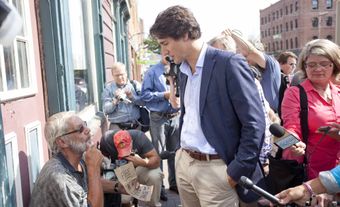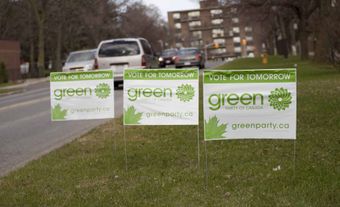The decision to vote for a particular political party is affected by many factors. These include socio-demographic factors, such as gender, race, ethnicity, religion and region of residence. Such factors can influence voters’ values and political attitudes. Together, all of these elements combine to shape an individual’s choice of political party during an election. Electoral dynamics vary considerably between individuals and groups; there is no one rule fits all.

Social Background
Voters’ social background can have an important long-term effect in shaping their attitudes in politics. Socio-demographic factors such as gender, race, ethnicity, religion and region of residence can shape which political party one prefers. (See also Canadian Party System.) These are considered long-term factors as they shape our attitudes from a young age.
Research on the effects of gender on political attitudes has shown that women tend to be more ideologically left-leaning and progressive than men. This means that women are more likely to be skeptical of the free market and less likely to hold socially conservative views. As such, women outside of Quebec are more likely than men to support left-wing parties like the New Democratic Party (NDP). Conversely, there is some limited evidence that women are less likely to support right-wing parties like the Conservative Party. Moreover, data shows that voters who identify as lesbian, gay, bisexual or transgender are particularly less supportive of the Conservatives. (See also Lesbian, Gay, Bisexual and Transgender Rights in Canada.)
Ethnicity, race and immigration play an important role in shaping political party preferences. Racialized Canadians (see Visible Minority) tend to be far more supportive of the Liberal Party than other Canadians. This is in line with how, historically, immigrants have been more likely to support the Liberals. However, there is evidence that the Conservative Party has made significant gains among white immigrants in recent years, particularly under Prime Minister Stephen Harper — to the extent that the Liberals no longer have a distinct advantage.
One long-standing socio-demographic factor of great importance is religion. Historically speaking, Catholics have been more likely to support the Liberals, while Protestants have preferred the Conservatives. Meanwhile, Canadians with no religious commitments have been more drawn to the NDP. However, the Catholic-Protestant religious split has weakened in recent years. In the wake of the Sponsorship scandal, Catholic support for the Liberals has dropped. (See Gomery Inquiry.) Instead, religiosity has increasingly become an important factor: non-religious people tend to be less supportive of the Conservatives and more favourable of the Liberals and the NDP.
Perhaps the most influential long-term socio-demographic factor is regionalism: where voters live and how it affects their electoral behaviour. With a country as large and diverse as Canada, different regions of the country often end up developing different attitudes and, sometimes, opposing interests. The most obvious example of regionalism is the Bloc Québécois, a federal party that only represents Quebec. Regionalism also has an immense influence in shaping Conservative and Liberal support. In the 2015 and 2019 elections, Conservative support was solidly anchored in the West — namely, in Alberta, Manitoba and Saskatchewan. Meanwhile, Liberal supporters were mainly in Ontario and Quebec, as well as in the Atlantic provinces.
DID YOU KNOW?
The Bloc mainly draws support from francophone Quebeckers; non-francophones living in Quebec were instead drawn to the Liberals and NDP.
Attitudes and Values
Canadians’ attitudes and values on social and economic issues have a large effect on their choice of political party. Opinions on important topics such as abortion, immigration, economic policy and LGBTQ2 rights can have an influence on vote choice.
In general, Canadians who support more socially conservative views, such as restricting abortion and LGBTQ2 rights, tend to be more supportive of the Conservative Party. The same can be said for those who prefer the free market over government intervention in the economy. Conservative supporters are also more likely to emphasize that minorities need to “fit in with mainstream Canadian society.”
On the other hand, Canadians who are more skeptical of the free market and those who tend to be more socially progressive are more likely to support the Liberal Party and the NDP. Conversely, Liberal and NDP supporters are more likely to be open to cultural diversity.
Partisan Identity
Voters’ social background and attitudes tend to align them with certain political parties. Unsurprisingly, voters who identify with a specific party will be more likely to vote for that party. However, vote choice and partisan identity are not the same: one does not perfectly predict the other. Indeed, while vote choice can change at each election, voters’ party identities tend to be more stable over time. However, just as party dynamics and voters change, so can individuals’ party affiliations. Typically, this happens with voters whose loyalty is not the strongest and who might be swayed by other factors.
Data from the four elections between 2000 and 2008 show that Conservative partisans tended to be the most loyal to their party over time. NDP supporters were overall the least loyal among the three main parties.
Short-Term Factors
Short-term factors are usually related to individual elections. Such factors include voters’ opinions on the economy, issues of the day and party leaders. These are shaped by long-term factors such as social background, values and party identity.
Economic Voting
Canadians’ perception of the state of the economy can affect their vote choice. However, the effect is generally fairly minor. Voters tend to not reward parties in power when the economy is doing well. But when economic disaster strikes, voters tend to punish the party in government.
Issue Voting
One key short-term factor is timely issues that voters deem to be important. These could include job creation, crime reduction and social programs. They could also be immediate topics such as corruption scandals like the Sponsorship scandal (see Gomery Inquiry) and social crises like the 2012 Quebec student strike.
Generally, the principle of issue voting is that voters will vote for parties they think are competent at managing certain issues. However, different issues tend to be prioritized in different elections. As such, a party’s reputation in managing an issue will only be relevant if that issue is viewed as important to voters.
Which issue has the most importance can often be shaped by political parties or the media, who can perform “agenda setting.” This involves pushing a topic to the forefront to grab voters’ attention and force public debate. (See also Public Relations; Public Opinion; Pressure Group.)
Leader Evaluation
Party leaders have become increasingly important in Canadian elections. There is a high degree of correlation between voters’ party choice and their approval ratings of that party’s leader. This is especially true for Conservative and Liberal voters but less so for NDP voters. Unsurprisingly, an unpopular leader tends to decrease his party’s electoral fortunes; a popular one will have the opposite effect.
Strategic Voting
Canada’s first-past-the-post electoral system tends to favour the two largest parties over the smaller ones. As such, voters sometimes feel the need to vote strategically; they vote for the party with the best chance of winning, even though it is not their preferred choice. Strategic voting is often used to prevent a party that the voter likes least from winning an election.
In the 2015 election, for example, upwards of 14 per cent of voters in British Columbia, Ontario and Quebec cast a strategic vote against their preferred party. Supporters of smaller parties, such as the Green Party of Canada and the NDP, were especially likely to cast a strategic vote for the Liberals. This was likely to prevent the Conservatives from winning the election.
See also Electoral Reform in Canada; Political Participation in Canada; Political Campaigning in Canada; Chief Electoral Officer.

 Share on Facebook
Share on Facebook Share on X
Share on X Share by Email
Share by Email Share on Google Classroom
Share on Google Classroom






